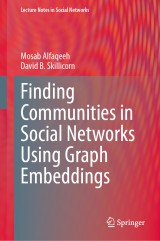Details
Finding Communities in Social Networks Using Graph Embeddings
Lecture Notes in Social Networks
|
CHF 212.50 |
|
| Verlag: | Springer |
| Format: | |
| Veröffentl.: | 29.06.2024 |
| ISBN/EAN: | 9783031609169 |
| Sprache: | englisch |
Dieses eBook enthält ein Wasserzeichen.
Beschreibungen
<p>Community detection in social networks is an important but challenging problem. This book develops a new technique for finding communities that uses both structural similarity and attribute similarity simultaneously, weighting them in a principled way. The results outperform existing techniques across a wide range of measures, and so advance the state of the art in community detection. Many existing community detection techniques base similarity on either the structural connections among social-network users, or on the overlap among the attributes of each user. Either way loses useful information. There have been some attempts to use both structure and attribute similarity but success has been limited. We first build a large real-world dataset by crawling Instagram, producing a large set of user profiles. We then compute the similarity between pairs of users based on four qualitatively different profile properties: similarity of language used in posts, similarity of hashtags used (which requires extraction of content from them), similarity of images displayed (which requires extraction of what each image is 'about'), and the explicit connections when one user follows another. These single modality similarities are converted into graphs. These graphs have a common node set (the users) but different sets a weighted edges. These graphs are then connected into a single larger graph by connecting the multiple nodes representing the same user by a clique, with edge weights derived from a lazy random walk view of the single graphs. This larger graph can then be embedded in a geometry using spectral techniques. In the embedding, distance corresponds to dissimilarity so geometric clustering techniques can be used to find communities. The resulting communities are evaluated using the entire range of current techniques, outperforming all of them. Topic modelling is also applied to clusters to show that they genuinely represent users with similar interests. This can form the basis for applications such as online marketing, or key influence selection.</p>
<p>Chapter 1: Introduction.- Chapter 2: Background.- Chapter 3: Building blocks.- Chapter 4: Social network data.- Chapter 5: Methodology.- Chapter 6: Results and validation.- Chapter 7: Conclusions.</p>
<p>Mosab ALfaqeeh is a doctoral graduate of the School of Computing at Queen’s. He works as a software developer.</p>
<p>David Skillicorn has worked extensively in adversarial data analytics, including the use of natural language processing and social network analysis. His work has applications in intelligence, policing, counterterrorism, and cybersecurity. He is the author of two hundred papers and several books, most recently "Cyberspace, Data Analytics, and Policing" (Taylor and Francis).</p>
<p>David Skillicorn has worked extensively in adversarial data analytics, including the use of natural language processing and social network analysis. His work has applications in intelligence, policing, counterterrorism, and cybersecurity. He is the author of two hundred papers and several books, most recently "Cyberspace, Data Analytics, and Policing" (Taylor and Francis).</p>
<p>Community detection in social networks is an important but challenging problem. This book develops a new technique for finding communities that uses both structural similarity and attribute similarity simultaneously, weighting them in a principled way. The results outperform existing techniques across a wide range of measures, and so advance the state of the art in community detection. Many existing community detection techniques base similarity on either the structural connections among social-network users, or on the overlap among the attributes of each user. Either way loses useful information. There have been some attempts to use both structure and attribute similarity but success has been limited. We first build a large real-world dataset by crawling Instagram, producing a large set of user profiles. We then compute the similarity between pairs of users based on four qualitatively different profile properties: similarity of language used in posts, similarity of hashtags used (which requires extraction of content from them), similarity of images displayed (which requires extraction of what each image is 'about'), and the explicit connections when one user follows another. These single modality similarities are converted into graphs. These graphs have a common node set (the users) but different sets a weighted edges. These graphs are then connected into a single larger graph by connecting the multiple nodes representing the same user by a clique, with edge weights derived from a lazy random walk view of the single graphs. This larger graph can then be embedded in a geometry using spectral techniques. In the embedding, distance corresponds to dissimilarity so geometric clustering techniques can be used to find communities. The resulting communities are evaluated using the entire range of current techniques, outperforming all of them. Topic modelling is also applied to clusters to show that they genuinely represent users with similar interests. This can form the basis for applications such as online marketing, or key influence selection.</p>
Substantially advances the state of the art in community detection by leveraging structure and attribute similarity Provides insight into a large real-world social network (Instagram) Shows that treating attributes of qualitatively different kinds as different pays off in revealing network structure
Diese Produkte könnten Sie auch interessieren:

Mixed-Signal Layout Generation Concepts

von: Chieh Lin, Arthur H.M. van Roermund, Domine Leenaerts

CHF 118.00

System-Level Design Techniques for Energy-Efficient Embedded Systems

von: Marcus T. Schmitz, Bashir M. Al-Hashimi, Petru Eles

CHF 118.00















